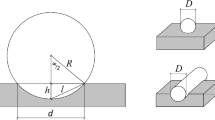Abstract
Purpose of this study was to assess a modification to the hardness determination method in order to mitigate the effect of visual measurements on the consistency of Brinell method and accuracy of the results. The amendment has been previously proposed by other researchers and refers to the automated determination of indentation diameter and relies on the ability of modern testing machines to accurately measure indentation depth, through which the calculation of indentation diameter is possible. From the results of this study it was shown that the hardness values acquired by the proposed modification presented statistically significant difference compared to those acquired using the visual method described in EN1534 (Wood and parquet flooring—determination of resistance to indentation (Brinell)—test method, 2000). Moreover, compared to the standard methodology, the application of the proposed amendment led to hardness values which are better correlated to density as well as Janka hardness for the six different solid wood species tested. Furthermore, the proposed modification resulted to hardness values which seem to be less affected by the presence of varnish coatings.




Similar content being viewed by others
References
American Society of Testing Materials (1997) Standard test methods for small clear specimens of timber. ASTM D 143. Annual book of ASTM standards, vol 4.10. Philadelphia, PA, USA
Bektas I, Alma MH, As N (2001) Determination of the relationships between Brinell and Janka hardness of eastern beech (Fagus orientalis Lipsky). For Prod J 51(11–12):84–88
Doyle J, Walker JCF (1985) Indentation Hardness of Wood. Wood Fiber Sci 17(3):369–376
EN 1534 (2000) Wood and parquet flooring—determination of resistance to indentation (Brinell)—test method. CEN, European Committee for Standardization, Brussels
Gindl W, Hansmann C, Gierlinger N, Schwanninger M, Hinterstoisser B, Jeronimidis G (2004) Using a water-soluble melamine-formaldehyde resin to improve the hardness of Norway spruce wood. J Appl Polym Sci 93(4):1900–1907. doi:10.1002/app.20653
Hansson L, Antti AL (2006) The effect of drying method and temperature level on the hardness of wood. J Mater Process Technol 171(3):467–470. doi:10.1016/j.jmatprotec.2005.08.007
Hirata S, Ohta M, Honma Y (2001) Hardness distribution on wood surface. J Wood Sci 47(1):1–7. doi:10.1007/BF00776637
Holmberg H (2000) Influence of grain angle on Brinell hardness of Scots pine (Pinus sylvestris L.). Holz als Roh-und Werkst 58:91–95. doi:10.1007/s001070050392
Kollman FFP, Côté AWA (1968) Principles of wood science and technology, vol I. Springer, New York
Kollmann F (1951) Technologie des Holzes und der Holzwerkstoffe, vol I. Springer, Berlin, pp 910–926
Laine K, Rautkari L, Hughes M (2013) The effect of process parameters on the hardness of surface densified Scots pine solid wood. Eur J Wood Wood Prod 71(1):13–16. doi:10.1007/s00107-012-0649-0
Lewis WC (1968) Hardness modulus as an alternate measure of hardness to the standard Janka ball for wood and wood-base materials. Research Note FPL-0189. U.S. Department of Agriculture, Forest Service, Forest Products Laboratory, Madison, Wisconsin
Niemz P, Stubi T (2000) Investigations of hardness measurements on wood based materials using a new universal measurement system. In: Proceedings of the symposium on wood machining, properties of wood and wood composites related to wood machining, Vienna, Austria, pp 51–61
Rautkari L, Kamke F, Hughes M (2011) Density profile relation to hardness of viscoelastic thermal compressed (VTC) wood composite. Wood Sci Technol 45(4):693–705. doi:10.1007/s00226-010-0400-0
Rautkari L, Properzi M, Pichelin F, Hughes M (2009) Surface modification of wood using friction. Wood Sci Technol 43(3–4):291–299. doi:10.1007/s00226-008-0227-0
Schwab E (1990) Die Härte von Laubhölzern für die Parkettherstellung. Holz als Roh-und Werkstoff 48(2):47–51. doi:10.1007/BF02610703
Sundqvist B, Karlsson O, Westermark U (2006) Determination of formic-acid and acetic acid concentrations formed during hydrothermal treatment of birch wood and its relation to colour, strength and hardness. Wood Sci Technol 40(7):549–561. doi:10.1007/s00226-006-0071-z
Wiemann M, Green D (2007) Estimating Janka hardness from specific gravity for tropical and temperate species. USDA Forest Service, Forest Products Laboratory, Research Paper, FPL-RP-643
Ylinen A (1943) Über den Einfluß der Rohwichte und des Spätholzanteils auf die Brinellhärte des Holzes. Holz als Roh-und Werkstoff 6(4):125–127. doi:10.1007/BF02605524
Author information
Authors and Affiliations
Corresponding author
Rights and permissions
About this article
Cite this article
Lykidis, C., Nikolakakos, M., Sakellariou, E. et al. Assessment of a modification to the Brinell method for determining solid wood hardness. Mater Struct 49, 961–967 (2016). https://doi.org/10.1617/s11527-015-0551-4
Received:
Accepted:
Published:
Issue Date:
DOI: https://doi.org/10.1617/s11527-015-0551-4




